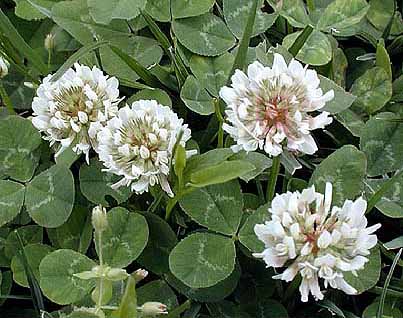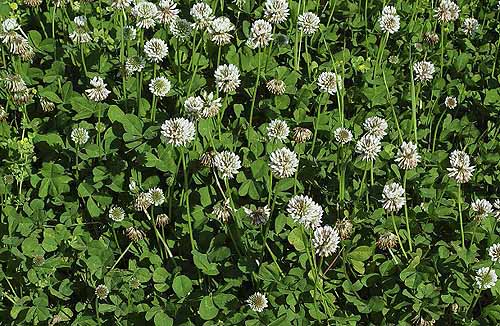White clover is a short plant that tolerates being cut and walked on very well. It has tri lobed leaves often with light inner variegated markings. The flowers small globe shapes made up of dozens of small white pea like flowers on short bendable stems.
For those interested in a more organic lawn with less fertilizers and chemicals adding white clover can be a excellent additive. has the wonderful ability to fix nitrogen which ensures that your lawn needs less maybe even no fertilizer to keep it healthy. Since it will flower when it is very short it also brings color and interest to an otherwise boring stretch of green. It is very tough and will stay green during times of drought when typical lawns turn brown and dull. More information on natural lawns. It will attract bees so some care is needed if going barefoot but flowers are bright and easy to avoid.
For those who have problems with rabbits in your flower beds, seeding the lawn with clover could be the answer. Rabbits love clover and will eat this over anything else. Most often they will stay on the lawn and not go in the flower beds. Suddenly they become cute rabbits you can enjoy watching eating the clover and not your flowers. - Don't try this with vegetable beds however, lettuce is even better than clover to a rabbit.
Our seed comes coated with an inoculum. (what’s this) At present we do not produce our own inoculum but are working toward this end and should be in about two years.
Scatter seed on the barer patches of your lawn. Seeding can be done at any time of the year when their is decent rainfall but the best results come in early spring. As soon as the ground is unfrozen the seed can be scattered. Seeds take several weeks to establish so you might not see anything for some time. We suggest you seed some the first year and see how well you like it or how much it spreads and then possibly seed again the following year. Clover will spread as it becomes established and you will see the grass around it turn a much deeper green as it benefits from the added nitrogen.







